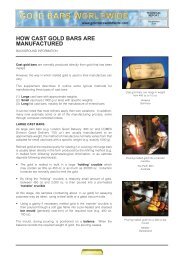Indian Gold Book:Indian Gold Book - Gold Bars Worldwide
Indian Gold Book:Indian Gold Book - Gold Bars Worldwide
Indian Gold Book:Indian Gold Book - Gold Bars Worldwide
You also want an ePaper? Increase the reach of your titles
YUMPU automatically turns print PDFs into web optimized ePapers that Google loves.
PRICING AND PROFITABILITY<br />
Top end retailers<br />
The labour charge for some standard machine-made items can be 10 - 20% less than standard handmade items.<br />
Category Handmade<br />
Labour charge per gramme<br />
Rs Approx US$<br />
Necklace 40 - 200 0.80 - 4.20<br />
Bangle 30 - 100 0.60 - 2.10<br />
Chain 30 - 80 0.60 - 1.60<br />
Earrings 75 - 100 1.60 - 2.10<br />
Ring 75 - 100 1.60 - 2.10<br />
Category Machine-made<br />
Labour charge per gramme<br />
Rs Approx US$<br />
Necklace 40 - 200 0.80 - 4.20<br />
Bangle 30 - 80 0.60 - 2.10<br />
Chain 30 - 70 0.60 - 1.40<br />
Earrings 60 - 90 1.20 - 1.90<br />
Ring 50 - 70 1.00 - 1.40<br />
Small suburban and rural retailers that fabricate on-site<br />
The table below illustrates how jewellery can sometimes be priced with a fixed labour charge in rupees per item.<br />
Category Weight Handmade<br />
Fixed labour charge<br />
Rs Approx US$<br />
Necklace 25 g 200 4.20<br />
Bangle 10 g 100 2.10<br />
Earrings 6 g 100 2.10<br />
Ring 5 g 100 2.10<br />
The table below illustrates how jewellery can sometimes be priced in rupees per gramme, regardless of the category, at<br />
different (and decreasing) rates according to the weight of the item.<br />
Item weight Handmade<br />
Variable labour charge per gramme<br />
Rs Approx US$<br />
2 g 25 0.50<br />
4 g 20 0.40<br />
8 g 15 0.30<br />
24 g 10 0.20<br />
Crude “money” jewellery<br />
The labour charge can be as low as Rs 2 - 5 per gramme (plus wastage) for simple items in K24, K23 and K22 at specified<br />
weights.<br />
For example, a retailer may stock a range of crude rings weighing 1/2, 1, 2, 3, 4, 5 and 10 grammes, and crude bangles at<br />
heavier weights.<br />
Wastage charges<br />
The wastage charge, sometimes referred to as a “polishing” charge, is intended to cover the gold lost in the fabrication and<br />
polishing of gold jewellery, and in many cases to contribute towards the total cost of the jewellery. For example, if the<br />
wastage charge is high, it enables the labour charge to be lower.<br />
While most outlets levy a wastage charge, it can also be absorbed within an overall “value addition” or total fabrication<br />
charge (including labour charges).<br />
The quoted wastage charge can vary from zero to 10%. A top end wastage charge tends to range between 4 - 8% (although it<br />
is often absorbed within a total “value addition” charge). In small suburban and rural areas, it typically ranges between 2 - 4%.<br />
158<br />
AN INTRODUCTION TO THE INDIAN GOLD MARKET

















